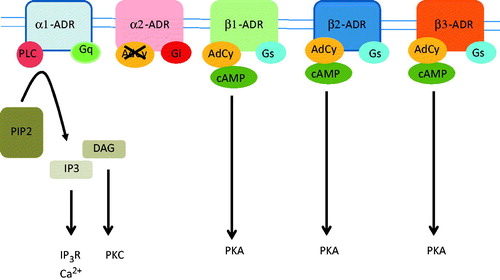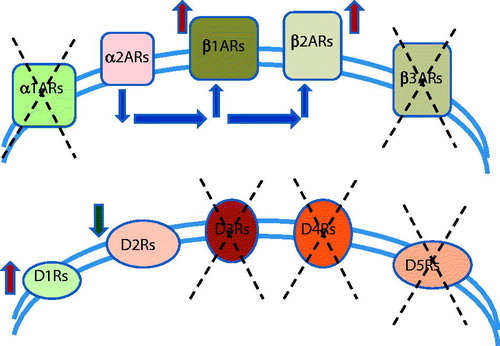Figures & data
Figure 1. Adrenergic receptors bind epinephrine and norepinephrine with a different affinity and they activate different metabolic pathways. The α1-ADRs are bound to Gq protein and they activate phospholipase C (PLC), which cleaves phosphatidylinositol 1,4-bisphosphate (PIP2) tp IP3 and diacylglycerol (DAG). IP3 activates IP3-receptors (IP3R), which are calcium-releasing channels that release calcium from the endoplasmic reticulum. DAG activates protein kinase C (PKC). The α2-ADRs bind Gi protein, which result in the inhibition af adenylate cyclase (AdCy) and inhibition of cAMP production. The β1, β2 and β3-ADRs are bound to the Gs protein and they activate AdCy, resulting in an increase of cAMP and activation of protein kinase A (PKA).

Table 1. Modulation of the β-ARs in various tumors.
Figure 2. From all types of adrenergic receptors, only type1 (β1ARs) and type 2 (β2ARs) adrenergic receptors were described to be up-regulated in solid tumors. The α2-adrenergic signaling can act through an autoreceptor mechanism to inhibit sympathetic catecholamine release and, thus, modulate established effects of β-adrenergic signaling on tumor progression-relevant biology. Involvement of other types of adrenergic receptors – α1ARs and β3ARs was not described yet. From all 5 types of dopamine receptors, only type 1 (D1Rs) were downregulated in breast tumors. Also, dopamine, through its specific dopamine receptor 2 (D2Rs), inhibits tumor growth by suppressing the actions of vascular permeability factor/vascular endothelial growth factor A on both tumor endothelial cells and bone marrow–derived endothelial progenitor cells. Involvement of other types of dopaminergic receptors – D3Rs and D4Rs and D5Rs was not described yet.

